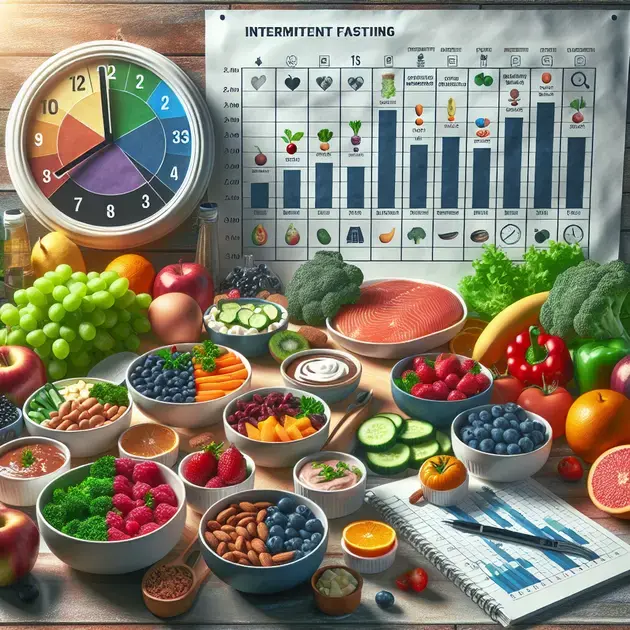If you’re curious about shedding pounds swiftly and effectively, the Fast Diet offers a popular and straightforward approach that has garnered attention worldwide. This “Quick Guide to the Fast Diet” will explore how this method helps you reduce calories significantly on specific days of the week, while eating normally on others. It’s not only about weight loss; recent studies also suggest potential benefits in overall health enhancement, including improved metabolic health.
The Fast Diet, often known as the 5:2 diet, involves eating your usual diet for five days of the week and restricting calorie intake for the other two. This guide will delve into how you can integrate this diet into your routine, what foods to eat and avoid on fasting days, and practical tips to handle the reduced-calorie days without stress. Understanding the right approach can make this diet a sustainable part of your healthy lifestyle.

Unlocking the Benefits of the Fast Diet
Unlocking the benefits of the Fast Diet requires a clear understanding of the principles behind this intermittent fasting approach. The 5:2 Diet, also known as the Fast Diet, involves eating normally for five days of the week and restricting calorie intake on the remaining two days. Research suggests that this method can aid weight loss, improve metabolic health, and potentially extend lifespan.
To get started with the Fast Diet, consider using the “Zero” app, available for both iOS and Android. This app helps track fasting periods, offers resources for beginners, and provides personalized fasting plans based on individual goals. By utilizing technology like the Zero app, you can stay on track and maximize the benefits of intermittent fasting.
One key aspect of unlocking the benefits of the Fast Diet is to stay consistent with your fasting days. Choose two non-consecutive days in a week where you will consume a restricted number of calories, typically around 500-600 for women and 600-700 for men. Planning your meals ahead of time and preparing low-calorie but nutrient-dense foods can make the fasting days more manageable.
Incorporating exercise into your routine while following the Fast Diet can further enhance its benefits. Engaging in moderate physical activity on fasting and non-fasting days can help maintain muscle mass, boost metabolism, and support overall well-being. Consider using fitness apps like MyFitnessPal or Fitbit to track your workouts and ensure you are meeting your activity goals.
As you progress with the Fast Diet, pay attention to how your body responds and adjust your fasting schedule or calorie intake as needed. Be mindful of any changes in energy levels, mood, or cravings, and consult with a healthcare provider if you have any underlying health conditions. With dedication and a well-rounded approach, unlocking the benefits of the Fast Diet can lead to sustainable weight management and improved health outcomes.
Integrating the 5:2 Diet into Your Routine
Integrating the 5:2 Diet into your routine involves establishing a structured plan that aligns with your lifestyle and goals. This intermittent fasting method requires careful consideration of fasting and non-fasting days, meal planning, and monitoring your progress to ensure adherence and effectiveness.
To seamlessly integrate the 5:2 Diet into your routine, explore resources such as the “Life Fasting Tracker” app, a comprehensive tool that offers fasting schedules, meal suggestions, and progress tracking features. By utilizing apps like Life Fasting Tracker, you can create a personalized fasting routine that fits your schedule and dietary preferences.
Start by designating two days of the week as your fasting days, ensuring they are not consecutive to allow for adequate nutrient intake on non-fasting days. Plan your meals in advance, focusing on nutrient-rich foods that provide essential vitamins, minerals, and fiber while keeping calorie intake within the recommended range during fasting periods.
Integrating physical activity into your routine can complement the 5:2 Diet by supporting weight loss, improving cardiovascular health, and enhancing overall fitness levels. Consider incorporating strength training, cardio workouts, or yoga sessions on both fasting and non-fasting days to maintain a balanced approach to health and well-being. Fitness apps like “Fitbod” or “Yoga Studio” can offer guidance and workout plans tailored to your preferences.
Consistency is key when integrating the 5:2 Diet into your routine. Stay committed to your fasting schedule, monitor your progress using the Life Fasting Tracker app, and make adjustments as needed based on your experiences and goals. By creating a sustainable routine that combines intermittent fasting, healthy eating, and regular exercise, you can successfully integrate the 5:2 Diet into your lifestyle for long-term benefits.
Tips for Successfully Implementing the Fast Diet
Implementing the Fast Diet successfully involves adopting strategies that support your fasting goals, promote adherence, and optimize results. Whether you are new to intermittent fasting or looking to enhance your current approach, incorporating these tips can help you navigate the Fast Diet with confidence.
Start by educating yourself about the principles of the Fast Diet and its potential benefits. Utilize reputable sources such as the official “Fast Diet” website or books by Dr. Michael Mosley, the creator of the 5:2 Diet, to understand the science behind intermittent fasting, meal planning tips, and success stories from individuals who have followed this approach.
Establish a support system to stay motivated and accountable throughout your Fast Diet journey. Connect with online communities, join social media groups focused on fasting, or enlist the support of friends and family members who can encourage you and share experiences. Consider using social platforms like Facebook groups or the Reddit community r/intermittentfasting for additional guidance and motivation.
Prepare your environment for success by stocking up on nutritious foods that align with the Fast Diet guidelines, creating a meal schedule that accommodates fasting days, and removing temptations that may hinder your progress. Apps like “MyNetDiary” or “Lifesum” can assist in meal planning, calorie tracking, and monitoring your food intake to support your fasting goals effectively.
Experiment with different fasting strategies, meal timings, and food choices to find what works best for your body and lifestyle. Stay flexible and open to adjustments as you navigate the Fast Diet, recognizing that individual preferences and needs may vary. Consulting with a registered dietitian or nutritionist can provide personalized guidance and ensure you are meeting your nutritional requirements while following the Fast Diet.
Stay patient and consistent on your Fast Diet journey, recognizing that sustainable results take time and dedication. Celebrate your achievements, whether they involve weight loss, improved energy levels, or better health markers, and stay focused on the long-term benefits of intermittent fasting. By implementing these tips and developing a positive mindset, you can successfully incorporate the Fast Diet into your routine and unlock its full potential for health and well-being.

**Fasting Protocols and Variations**
Fasting Protocols
When it comes to fasting protocols, there are several variations that individuals can choose from depending on their goals and lifestyle. One popular option is the 16/8 method, where individuals fast for 16 hours and limit their eating window to 8 hours. This can be easily incorporated into daily life by skipping breakfast and eating meals within a specific timeframe.
Another common fasting protocol is the 5:2 diet, where individuals eat normally for 5 days a week and restrict their calorie intake to 500-600 calories for the remaining 2 days. This allows for flexibility and can be adjusted based on individual preferences and schedules.
For those looking for a more structured approach, the alternate day fasting method involves fasting every other day and eating normally on non-fasting days. This can be challenging for some people but can provide effective results when done consistently.
Additionally, the OMAD (one meal a day) protocol is another option where individuals consume all their daily calories in one large meal. This can simplify meal planning and may help with portion control.
Overall, finding the right fasting protocol is key to success and should be based on individual needs, preferences, and lifestyle.
Healthy Meal Ideas for the Fast Diet
When following a fast diet, it’s important to focus on nourishing and balanced meals that provide essential nutrients while supporting the fasting phase. Incorporating lean proteins, whole grains, fruits, and vegetables can help maintain energy levels and promote satiety.
Some healthy meal ideas for the fast diet include grilled chicken with quinoa and roasted vegetables, a spinach and berry smoothie with protein powder, and a Mediterranean salad with chickpeas and feta cheese.
Snack options can include Greek yogurt with almonds, carrot sticks with hummus, and apple slices with peanut butter. It’s important to listen to your body’s hunger cues and choose foods that will keep you satisfied during fasting periods.
Experimenting with different recipes and meal combinations can help prevent boredom and ensure a variety of nutrients are consumed. Planning ahead and meal prepping can also be beneficial for staying on track with the fast diet.
Remember to stay hydrated, incorporate fiber-rich foods, and limit processed foods and added sugars for optimal results while following the fast diet.
Tracking Progress and Adjustments for Success
Tracking progress and making adjustments are essential components of achieving success with any fasting protocol. Keeping a food journal, monitoring weight changes, and tracking energy levels can provide valuable insights into how the fast diet is impacting your body.
Measuring key metrics such as body fat percentage, muscle mass, and waist circumference can also help gauge progress and make informed adjustments to your fasting routine. Consulting with a healthcare provider or nutritionist can offer additional guidance and support.
When tracking progress, it’s important to be consistent and patient with the process. Celebrate small victories, such as improved focus or increased energy, and use setbacks as opportunities for learning and growth.
Adjustments to your fasting protocol may include changing your eating window, incorporating more nutrient-dense foods, or adjusting portion sizes based on hunger cues. It’s important to listen to your body and make changes that align with your goals and overall well-being.
By staying accountable, listening to your body, and making informed adjustments, you can set yourself up for long-term success with the fast diet and achieve your health and wellness goals.
Conclusion
Exploring various fasting protocols and variations can provide individuals with the flexibility to choose a method that aligns with their goals and lifestyle. Options like the 16/8 method, 5:2 diet, alternate day fasting, and OMAD protocol offer diverse approaches to fasting, allowing for personalization and adherence.
When following a fast diet, incorporating nutrient-dense and balanced meals is essential for sustaining energy levels and promoting satiety. Meal ideas such as grilled chicken with quinoa, spinach and berry smoothie, and Mediterranean salad offer delicious and wholesome options to support the fasting phase.
Tracking progress and making adjustments play a crucial role in the success of any fasting routine. Monitoring metrics like weight changes, body composition, and energy levels can guide individuals in refining their fasting protocols for optimal results. Seeking guidance from healthcare providers or nutritionists can further enhance progress and provide additional support.
By staying consistent, patient, and responsive to individual cues, individuals can navigate through the challenges of fasting, celebrate achievements, and learn from setbacks. Making informed adjustments, listening to the body’s signals, and staying accountable are key factors in achieving long-term success with the fast diet, leading to improved health and wellness outcomes.
